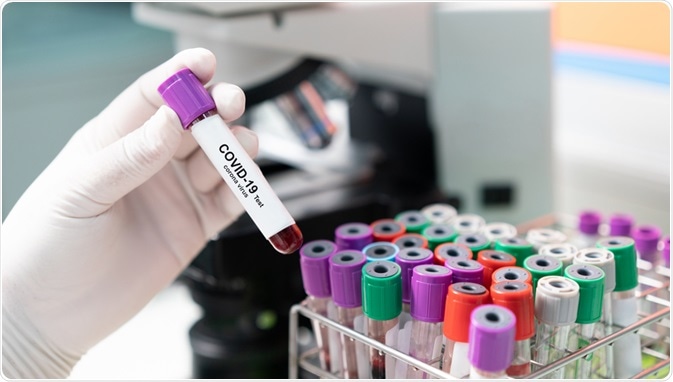Back in December 2019, a cluster of patients in Wuhan, China, developed pneumonia of an unknown etiology. Since then, the full genome of the severe acute respiratory syndrome coronavirus 2 (SARS-CoV-2) has been sequenced and it has spread around the world resulting in a global pandemic.
 Image Credit: CrispyPork / Shutterstock.com
Image Credit: CrispyPork / Shutterstock.com
In just one year, there have been over 71 million confirmed cases of the virus, with it claiming over 1.6 million lives. All corners of the world have been impacted, with 220 countries, areas, or territories reporting cases.
While most people infected with SARS-CoV-2 experience only mild to moderate symptoms of the respiratory illness and tend to recover without the need for hospitalization, people in “at-risk” groups, such as those with cancer, cardiovascular disease, chronic respiratory disease, and the elderly are more likely to become seriously ill and die.
To tackle the spread of the disease, the World Health Organization (WHO) has stressed the importance of making testing more widely available, amongst other strategies, such as prevention strategies and contact tracing.
In terms of testing, there are two types of tests currently relied upon, real-time PCR (RT-PCR) and blood antibody-based testing. New research has helped to develop another method of testing that may prove invaluable to enhancing COVID-19 testing capacity, helping countries worldwide tackle the SARS-CoV-2 pandemic.
Scientists in Mumbai recently published a paper in the journal Future Virology, explaining how they have established a flow cytometry-based high-throughput screening system that sees particles of the virus binding to specific primary antibodies to create a complex that binds to fluorescent-tagged secondary antibodies. This action creates a fluorescence signal that is measurable, allowing scientists to detect the presence of the virus in a sample.
Currently Used COVID-19 Tests
Currently, there are two types of tests widely used to detect SARS-CoV-2. The first is molecular testing, such as reverse transcription-polymerase chain reaction (RT-PCR tests) which can detect the genetic material of the virus, and antigen tests that look for known proteins associated with the virus. Both of these tests can be used to diagnose a current infection with SARS-CoV-2.
The second class of diagnostic tests are antibody tests. These tests detect the presence of antibodies in the blood that are generated in response to infection with a virus. However, antibodies take time to build up in the body and can linger after the infection has cleared. Therefore, these tests can only be used to determine whether someone has been infected with the virus, they are not diagnostic.
Experts have expressed the importance of accurate and accessible COVID-19 testing in mediating transmission of the virus. This is particularly important while we wait for the vaccine to be rolled out, and until we identify a successful treatment strategy to protect those at-risk.
While PCR tests have long been considered the gold standard, the process is lengthy and the throughput of the system is low. Additionally, the accuracy of antibody-based detection is not high enough to be immune to false or nonspecific results. Due to the limitations of current tests, there is a need for an accurate, high-throughput and rapid method of testing.
Using Flow Cytometry to Detect COVID-19
New research has suggested an alternative flow cytometry-based method of testing for the SARS-CoV-2 virus. Flow cytometry is a method that is used across different fields of science to analyze single cells or particles. The technology exposes each particle to lasers and measures the resultant visible light scatter as well as one or more fluorescence parameters.
Data collected on light scatter can indicate the size of the cell, as well as the granularity and internal complexity of a cell. The samples are stained with fluorescent dyes and fluorescently conjugated antibodies which allow scientists to detect the presence of certain viruses or antibodies to viruses.
The team in Mumbai has developed flow cytometry technology to establish a new method of SARS-CoV-2 virus testing. They believe their method will enhance the testing scale of COVID-19 cases. The SARS-CoV-2 is constructed of a 29–30 kb chain of positive single-stranded RNA. Its size ranges from around 70 to 90 nm.
Previous studies have demonstrated how the dengue virion (40–60 nm) can be detected using a combination of fluorescently labeled antibodies and magnetic nanoparticles (MNPs). In their new paper, the team in Mumbai describes how they have adapted this approach, labeling the viral particle surface with antigen-specific primary antibodies and following with a secondary antibody conjugated to a fluorescent dye to identify the presence of the SARS-CoV-2 virus.
The new flow cytometry-based method will likely be vital to the future of COVID-19 testing. The new study demonstrates how the visions of SARS-CoV-2 can effectively be tagged with specific fluorescent-labeled antibodies, which can be detected using advanced flow virometry in a high-throughput manner. The newly established test could process around 2,000 tests daily using a single set of equipment, offering a reliable, rapid, and accurate method of testing.
Sources
Coronavirus. World Health Organization. Available at: https://www.who.int/health-topics/coronavirus#tab=tab_1
Coronavirus Disease 2019 Testing Basics. U.S. Food and Drug Administration. Available at: www.fda.gov/.../coronavirus-disease-2019-testing-basics
Coronavirus disease (COVID-19) pandemic. World Health Organization. Available at: https://www.who.int/emergencies/diseases/novel-coronavirus-2019
McKinnon, K., 2018. Flow Cytometry: An Overview. Current Protocols in Immunology, 120(1). https://www.ncbi.nlm.nih.gov/pmc/articles/PMC5939936/
Soni, N., Pai, P., Krishna Kumar, G., Prasad, V., Dasgupta, S. and Bhadra, B., 2020. A flow virometry process proposed for detection of SARS-CoV-2 and large-scale screening of COVID-19 cases. Future Virology, 15(8), pp.525-532. https://www.ncbi.nlm.nih.gov/pmc/articles/PMC7434223/
Further Reading